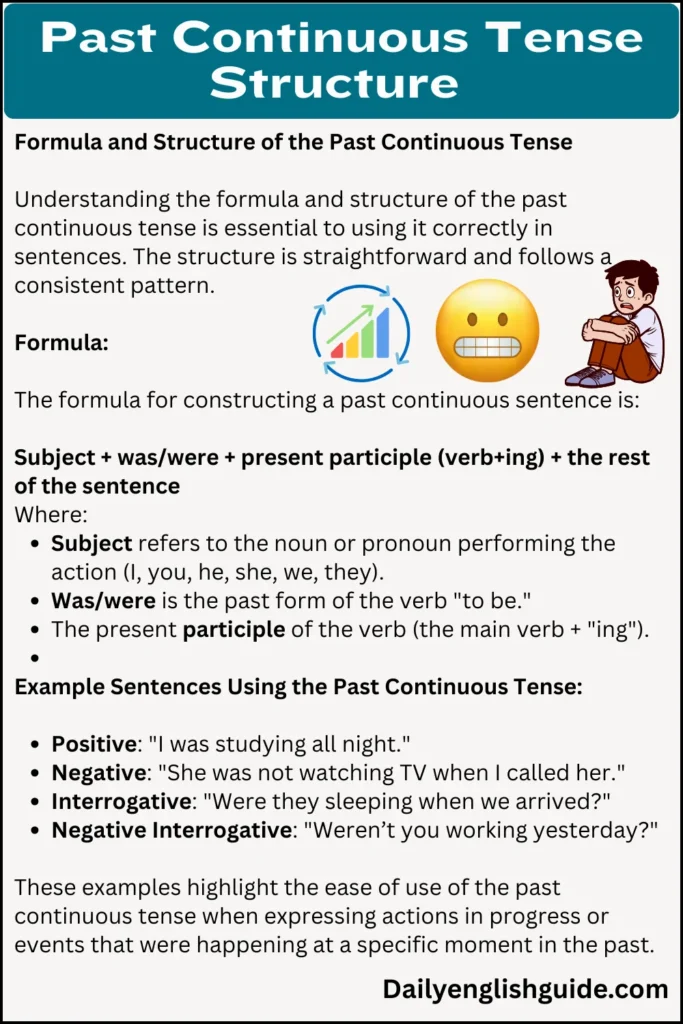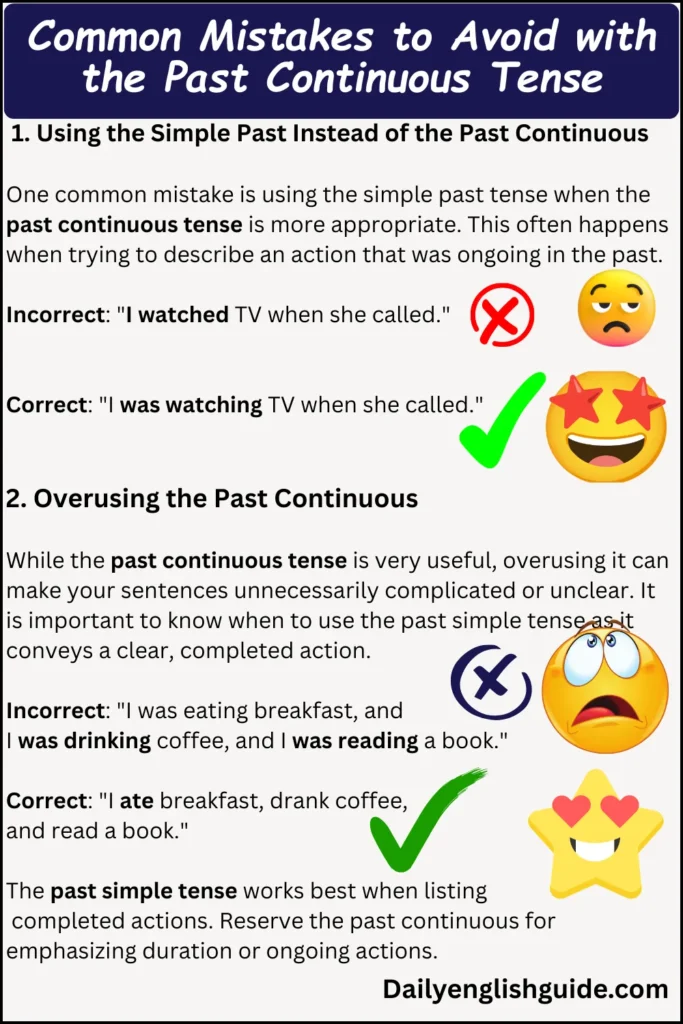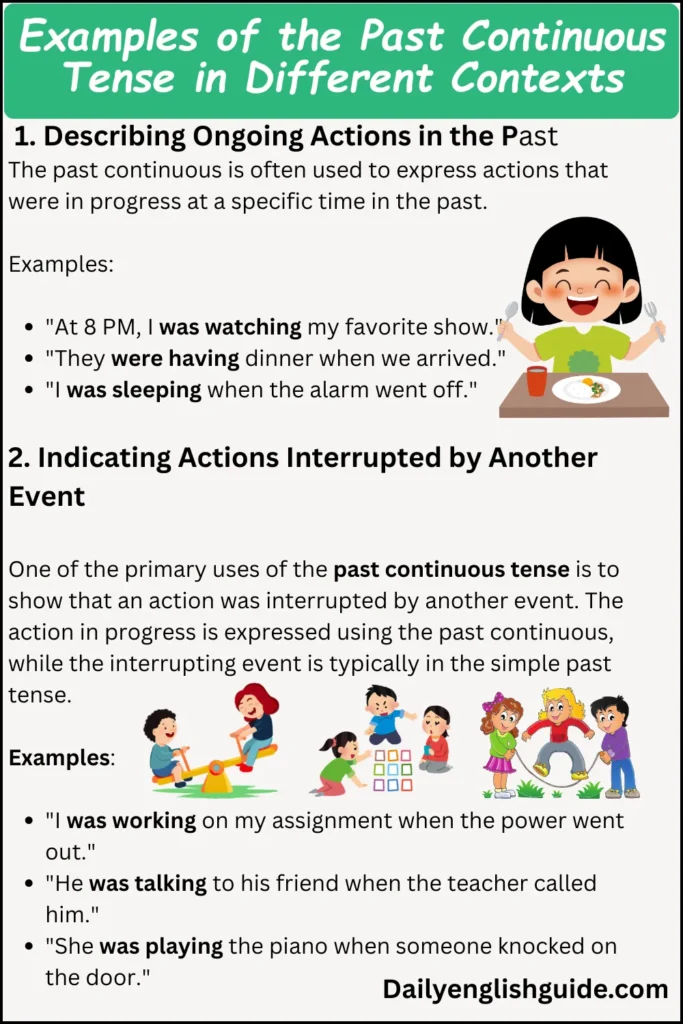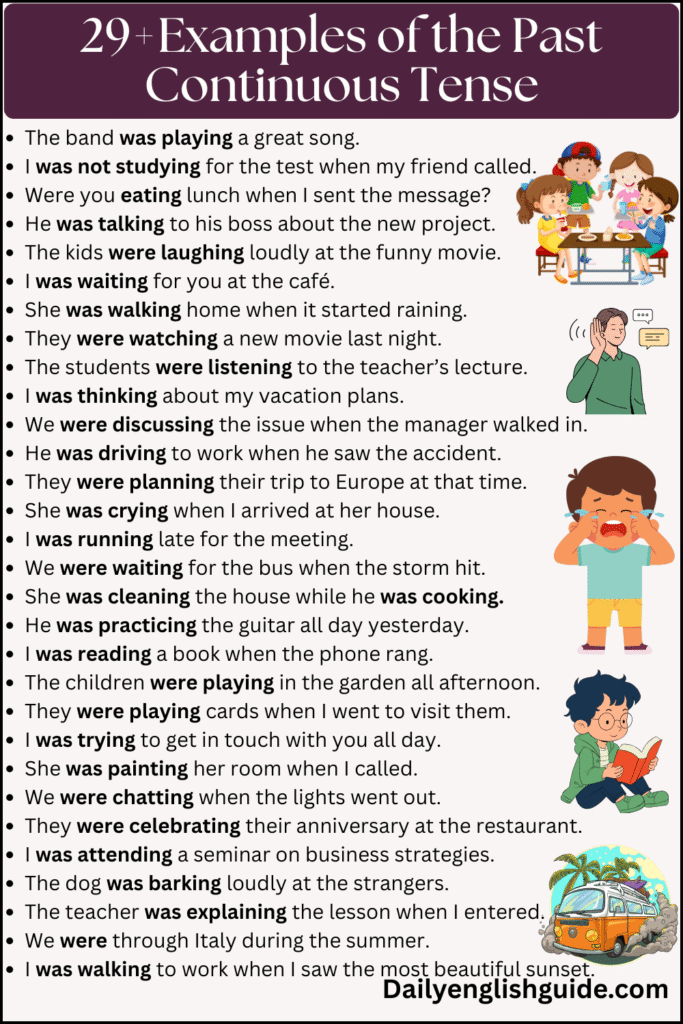The past continuous tense, often referred to as the past progressive tense, is a vital part of English grammar. It describes actions or events that were in progress at a specific point in the past. It is particularly useful when expressing ongoing actions, events that were interrupted, or parallel actions happening at the same time. This tense helps convey the nature of an action that was occurring during a specific time in the past, offering more detail and context than simply using the past simple tense.
In this comprehensive guide, we will break down everything you need to know about the past continuous tense, including its structure, usage, and examples. By the end, you will understand how to use this tense effectively to enhance your English communication.
What Is the Past Continuous Tense?
At its core, the past continuous tense is a verb tense that is used to describe an action or event that was ongoing at a particular point in the past. It is formed by combining the past tense of the auxiliary verb “to be” (was/were) with the present participle (the -ing form) of the main verb.
Definition in Different Dictionaries
To further solidify your understanding of this tense, let’s see how different prominent dictionaries define the past continuous tense:
-
Cambridge Dictionary defines it as: “The grammatical form used for an action that someone was doing or an event that was happening at a particular time.”
-
Macmillan Dictionary explains it as: “The tense used to talk about actions or behavior that were begun and ended at some time in the past.”
-
Collins Dictionary provides this definition: “A verb form consisting of an auxiliary ‘be’ in the past tense, followed by a present participle, and used to indicate that an action or event was incomplete or in progress at a point in the past.”
From these definitions, it’s clear that the past continuous tense emphasizes the ongoing nature of actions in the past, making it distinct from the simple past tense, which merely denotes completed actions.

Formula and Structure of the Past Continuous Tense
Understanding the formula and structure of the past continuous tense is essential to using it correctly in sentences. The structure is straightforward and follows a consistent pattern.
Formula:
The formula for constructing a past continuous sentence is:
Subject + was/were + present participle (verb+ing) + the rest of the sentence
Where:
-
Subject refers to the noun or pronoun performing the action (I, you, he, she, we, they).
-
Was/were is the past form of the verb “to be.”
-
The present participle of the verb (the main verb + “ing”).
Example Sentences Using the Past Continuous Tense:
-
Positive: “I was studying all night.”
-
Negative: “She was not watching TV when I called her.”
-
Interrogative: “Were they sleeping when we arrived?”
-
Negative Interrogative: “Weren’t you working yesterday?”
These examples highlight the ease of use of the past continuous tense when expressing actions in progress or events that were happening at a specific moment in the past.
Key Points to Remember:
-
The past continuous tense is always formed with the past tense of the auxiliary verb “to be” (was/were) and a verb ending in -ing.
-
This tense is often used to emphasize the duration of an action or to describe background events in storytelling.
When to Use the Past Continuous Tense
The past continuous tense is commonly used in the following situations:
1. To Describe Ongoing Actions or Events in the Past
Use the past continuous to describe actions that were in progress at a specific time in the past. These actions may or may not have been completed by the time of reference.
For example:
-
“At 7 PM yesterday, I was watching a movie.”
-
“While I was studying, my friend was cooking dinner.”
These sentences indicate that the actions were happening continuously at a particular point in time.
2. To Express Interrupted Actions in the Past
The past continuous is used when one action was interrupted by another action. In this case, the ongoing action is expressed in the past continuous, and the interrupting action is typically in the simple past tense.
For example:
-
“I was reading a book when the phone rang.”
-
“She was walking to work when it started raining.”
3. To Talk About Parallel Actions in the Past
When two actions are happening at the same time in the past, we use the past continuous tense for both actions.
For example:
-
“While they were playing soccer, we were watching them.”
-
“He was working on his laptop while she was cleaning the house.”
4. To Set the Scene in the Past
The past continuous tense is often used in storytelling to describe what was happening in the background during a particular moment in the past.
For example:
-
“It was raining, and the wind was howling as we walked home.”
-
“When she entered the room, people were chatting and laughing.”
These examples illustrate how the past continuous adds richness to the narrative by focusing on the ongoing atmosphere or action.
Structure of the Past Continuous Tense
Once you understand the formula and structure, it’s essential to know how to use the past continuous tense in different sentence forms. In English, we can form four types of sentences using this tense:
1. Positive Sentences (Affirmative)
In positive sentences, the structure is straightforward. You begin with the subject, followed by was/were, and then the present participle of the main verb.
Structure:
-
Subject + was/were + present participle (verb + -ing) + the rest of the sentence.
Examples:
-
“She was studying for her exams all night.”
-
“They were playing football when I saw them.”
-
“I was reading a book at 10 PM last night.”
2. Negative Sentences
In negative sentences, we add not after the auxiliary verb was/were. The structure is quite similar to positive sentences, but with the inclusion of not to indicate negation.
Structure:
-
Subject + was/were + not + present participle (verb + -ing) + the rest of the sentence.
Examples:
-
“I was not working at that time.”
-
“She was not listening to me when I spoke.”
-
“They were not studying when the teacher entered.”
3. Interrogative Sentences (Questions)
In interrogative sentences, the auxiliary verb was/were comes first, followed by the subject, and then the present participle of the verb. This inversion of the subject and auxiliary verb is what makes the sentence a question.
Structure:
-
Was/were + subject + present participle (verb + -ing) + the rest of the sentence?
Examples:
-
“Were you watching TV when I called?”
-
“Was she working late last night?”
-
“Were they playing when the rain started?”
4. Negative Interrogative Sentences (Negative Questions)
To form negative interrogative sentences, you simply combine the negative form of was/were (wasn’t/ weren’t) with the subject and present participle.
Structure:
-
Wasn’t/weren’t + subject + present participle (verb + -ing) + the rest of the sentence?
Examples:
-
“Wasn’t she studying when I visited?”
-
“Weren’t you working when I called you?”
-
“Wasn’t it raining when you went out?”
By mastering these four sentence structures, you’ll be able to express a wide range of actions and events that were happening at a specific time in the past.

Common Mistakes to Avoid with the Past Continuous Tense
Despite its relatively simple structure, learners often make a few mistakes when using the past continuous tense. Let’s explore some common errors and how to avoid them.
1. Using the Simple Past Instead of the Past Continuous
One common mistake is using the simple past tense when the past continuous tense is more appropriate. This often happens when trying to describe an action that was ongoing in the past.
Incorrect: “I watched TV when she called.”
Correct: “I was watching TV when she called.”
The past continuous tense is used here to emphasize that the action of watching TV was still in progress when the phone call happened.
2. Overusing the Past Continuous
While the past continuous tense is very useful, overusing it can make your sentences unnecessarily complicated or unclear. It is important to know when to use the past simple tense as it conveys a clear, completed action.
Incorrect: “I was eating breakfast, and I was drinking coffee, and I was reading a book.”
Correct: “I ate breakfast, drank coffee, and read a book.”
The past simple tense works best when listing completed actions. Reserve the past continuous for emphasizing duration or ongoing actions.
3. Using “Was/Were” with Stative Verbs
Stative verbs describe a state rather than an action (e.g., “be,” “know,” “like,” “belong”). These verbs generally do not work well in the continuous tenses, including the past continuous tense.
Incorrect: “I was knowing her for five years.”
Correct: “I knew her for five years.”
In this case, “knew” is the correct form, as “know” is a stative verb and does not typically appear in the continuous tense.
4. Incorrect Word Order in Interrogative Sentences
Sometimes, learners mistakenly use the wrong word order in questions. Remember, in interrogative sentences, the auxiliary verb was/were comes before the subject.
Incorrect: “She was not going to the party, was she?”
Correct: “She wasn’t going to the party, was she?”
Here, the word order must be reversed in the second part of the question to form a correct negative question.
When to Use Past Continuous in Narration
The past continuous tense plays a crucial role in storytelling and narration. It is used to describe the background or setting of events in the past, often adding depth to the narrative.
For example, consider the following two sentences:
-
Simple Past: “He entered the room, and the phone rang.”
-
Past Continuous: “He was entering the room when the phone rang.”
The second sentence, with the past continuous, conveys that the action of entering the room was in progress when it was interrupted by the phone call. The past continuous adds more detail and context, making the action feel more vivid and real.
This use of past continuous allows the speaker or writer to emphasize the continuity and interruption of actions, providing a fuller picture of past events.

Examples of the Past Continuous Tense in Different Contexts
To fully grasp the use of the past continuous tense, it’s helpful to examine various contexts in which it is applied. Below, we provide a range of examples from different situations to demonstrate how this tense functions in everyday conversations and narratives.
1. Describing Ongoing Actions in the Past
The past continuous is often used to express actions that were in progress at a specific time in the past.
Examples:
-
“At 8 PM, I was watching my favorite show.”
-
“They were having dinner when we arrived.”
-
“I was sleeping when the alarm went off.”
In these examples, the actions were ongoing at the stated time in the past, indicating that they had not yet been completed when other events occurred.
2. Indicating Actions Interrupted by Another Event
One of the primary uses of the past continuous tense is to show that an action was interrupted by another event. The action in progress is expressed using the past continuous, while the interrupting event is typically in the simple past tense.
Examples:
-
“I was working on my assignment when the power went out.”
-
“He was talking to his friend when the teacher called him.”
-
“She was playing the piano when someone knocked on the door.”
Here, the ongoing action (working, talking, playing) is interrupted by a separate event (power going out, teacher calling, door knocking).
3. Describing Two or More Simultaneous Actions
The past continuous is also useful for describing two or more actions happening at the same time in the past. This helps convey the sense that different activities were happening concurrently.
Examples:
-
“I was studying while my brother was playing outside.”
-
“They were cooking dinner while we were setting the table.”
-
“We were watching a movie and they were talking loudly.”
These sentences show that multiple activities were occurring at the same time, highlighting the parallel nature of the actions.
4. Setting the Scene in Stories
The past continuous is commonly used to provide background information or to set the scene in storytelling. It helps establish a vivid image of what was happening at a specific time in the past.
Examples:
-
“It was raining heavily as we walked to the car.”
-
“The sun was setting behind the mountains when we reached the top.”
-
“The children were playing outside when the storm started.”
In these examples, the use of the past continuous tense emphasizes the atmosphere or environment that sets the context for the main events of the story.
5. Expressing Duration of Past Actions
Sometimes, the past continuous tense is used to emphasize the duration of an action that was happening in the past. This use of the tense indicates that something was happening over a period of time, rather than as a brief action.
Examples:
-
“He was studying for hours last night.”
-
“I was waiting for her for more than an hour.”
-
“They were traveling around Europe for a whole year.”
These examples show that the action was ongoing for a long time, emphasizing the duration of the activity.
Frequently Asked Questions (FAQs)
To further clarify any confusion regarding the past continuous tense, here are answers to some common questions that learners often have:
1. What is the difference between the past simple and past continuous tense?
While both the past simple and past continuous tenses are used to talk about actions in the past, the past continuous emphasizes the ongoing nature or duration of an action, while the past simple focuses on completed actions.
Example:
-
Past Simple: “I ate dinner at 7 PM.”
-
Past Continuous: “I was eating dinner when she called.”
In the first sentence, the action is completed, while in the second, the action of eating was in progress when another event (the phone call) happened.
2. Can the past continuous tense be used with stative verbs?
Generally, stative verbs, which describe a state rather than an action (such as “believe,” “own,” or “know”), do not commonly appear in the past continuous tense. These verbs are typically used in the simple past tense.
Incorrect: “I was knowing her for years.”
Correct: “I knew her for years.”
However, some stative verbs can be used in the continuous tense when they are expressing a temporary state or an action.
Example: “I was thinking about going on vacation.”
3. How do I form negative and interrogative sentences in the past continuous tense?
-
Negative Sentence: Add not after the auxiliary verb was or were.
-
“I was not working yesterday.”
-
“They were not playing outside.”
-
-
Interrogative Sentence: Invert the order of the subject and auxiliary verb was/were.
-
“Was she watching TV when you arrived?”
-
“Were they studying at 10 PM?”
-
4. Can the past continuous be used with time expressions like “while,” “when,” and “at”?
Yes, the past continuous tense is often used in conjunction with time expressions to show when the action was happening.
Examples:
-
“I was reading a book when the phone rang.”
-
“She was studying while I was cooking.”
-
“They were waiting at the station when we arrived.”
These time expressions help pinpoint the specific moment or time during which the action was taking place.
Common Uses of the Past Continuous Tense
The past continuous tense can be employed in a variety of situations to convey specific meanings and nuances in communication. By understanding these common uses, you can apply the tense more accurately in different contexts.
1. To Describe an Action in Progress at a Specific Time in the Past
The past continuous is frequently used to indicate an action that was in progress at a particular time in the past. This helps to specify the exact moment when something was happening.
Examples:
-
“At 6 PM, I was walking to the store.”
-
“Last Friday, we were sitting in the park when it started raining.”
-
“I was talking to my friend when my phone battery died.”
In these examples, the action (walking, sitting, talking) was happening during the given time in the past, highlighting its ongoing nature.
2. For Simultaneous Actions in the Past
The past continuous can also be used to show that two actions were happening at the same time in the past. This allows us to express parallel actions or events that occurred simultaneously.
Examples:
-
“While she was studying, he was playing video games.”
-
“They were watching a movie, and I was cleaning the house.”
-
“We were discussing the project while the others were working on their tasks.”
This use of the past continuous shows that the actions occurred at the same time, providing a clearer picture of what was happening in parallel.
3. To Highlight the Duration of an Action in the Past
Another common use of the past continuous tense is to emphasize how long an action lasted in the past. This can give more context and detail about the time an event or activity took.
Examples:
-
“I was studying for hours yesterday.”
-
“They were playing soccer for the entire afternoon.”
-
“We were working on the report all week.”
These sentences demonstrate the extended nature of the actions, helping the reader or listener understand the duration of each event.
4. For Describing Interrupted Actions
As mentioned earlier, the past continuous is used to describe actions that were interrupted by another event or action. This highlights the ongoing nature of the activity when it was cut off by an external factor.
Examples:
-
“I was watching TV when the power went out.”
-
“She was reading a book when I called her.”
-
“They were having dinner when the guests arrived.”
In these cases, the use of the past continuous emphasizes that the first action was ongoing when another event interrupted it.
5. For Background Descriptions in Narratives
In storytelling, the past continuous is frequently used to set the scene or provide background information. It paints a picture of what was happening at a particular time or during an event.
Examples:
-
“The sun was setting as we walked down the street.”
-
“She was talking to her friends when the phone rang.”
-
“The children were playing in the yard while the adults were inside having tea.”
These examples show how the past continuous tense provides context and atmosphere, helping to set the stage for the main events of the story.

30 More Examples of the Past Continuous Tense
Now that you’ve learned about the different uses of the past continuous tense, it’s time to look at additional examples to reinforce your understanding. Here are 30 more sentences using the past continuous tense:
-
The band was playing a great song.
-
I was not studying for the test when my friend called.
-
Were you eating lunch when I sent the message?
-
He was talking to his boss about the new project.
-
The kids were laughing loudly at the funny movie.
-
I was waiting for you at the café.
-
She was walking home when it started raining.
-
They were watching a new movie last night.
-
The students were listening to the teacher’s lecture.
-
I was thinking about my vacation plans.
-
We were discussing the issue when the manager walked in.
-
He was driving to work when he saw the accident.
-
They were planning their trip to Europe at that time.
-
She was crying when I arrived at her house.
-
I was running late for the meeting.
-
We were waiting for the bus when the storm hit.
-
She was cleaning the house while he was cooking.
-
He was practicing the guitar all day yesterday.
-
I was reading a book when the phone rang.
-
The children were playing in the garden all afternoon.
-
They were playing cards when I went to visit them.
-
I was trying to get in touch with you all day.
-
She was painting her room when I called.
-
We were chatting when the lights went out.
-
They were celebrating their anniversary at the restaurant.
-
I was attending a seminar on business strategies.
-
The dog was barking loudly at the strangers.
-
The teacher was explaining the lesson when I entered.
-
We were traveling through Italy during the summer.
-
I was walking to work when I saw the most beautiful sunset.
Conclusion
The past continuous tense plays a crucial role in English grammar by helping to describe actions, events, and states in progress at specific times in the past. Understanding how to use this tense allows you to provide more context, create vivid narratives, and express ongoing actions with ease.
By mastering the structure, common uses, and various sentence forms (positive, negative, and interrogative), you’ll be able to communicate with more precision and clarity. Remember, practice is key to mastering the past continuous tense, and the more you use it in everyday situations, the more natural it will feel.
